Sign up for Chalkbeat Indiana’s free daily newsletter to keep up with Indianapolis Public Schools, Marion County’s township districts, and statewide education news.
This school year, Ace Prep Academy Principal Amanda Liles started getting in her car and driving to pick up her students herself.
The K-5 school of 110 students on the city’s northeast side can’t afford transportation through large bus companies. For the most part, families have to get their children there on their own — which means even one car issue can lead a student to miss a lot of school or withdraw from Ace Prep.
At Hope Academy, the state’s only high school for students with substance-use struggles, grant funding paid for a minibus to help pick up more students around and outside Marion County.
And at Irvington Community Schools, which does not offer universal transportation, officials have used pandemic relief funding to pay for a car service to bring students to school whose families have trouble getting them there on their own. That ends this school year, however, because those funds will soon expire.
This is the state of charter school transportation in Indianapolis, home to over 70 charters that range in size from under 50 to over 1,000 students. And while they are public schools, many struggle to afford transportation for families who want to attend. In some cases, that makes charters an option only for those families who can afford to drive or live close enough to walk to school.
Unlike other states, Indiana does not offer schools any funds or incentives specifically for providing transportation. Both traditional school districts and charters must pay for transportation needs out of their operating budgets, according to the Indiana Department of Education.
But while districts often have larger buying power and can take advantage of economies of scale, charter leaders say the small size of their schools and budgets restrict transportation options in a city with a limited number of bus companies. Providing the service themselves can be costly and time-consuming.
And charters get inadequate transportation funding from the state and from local property taxes, leaders say, which makes scrounging for funding even harder.
The issue, parents and school leaders say, is one of equity.
“Maybe it’s difficult for you to be here or there at a certain time,” Liles said of families’ ability to drop off their children. “That shouldn’t determine your child’s access to a high-quality education.”
Now, the charter-friendly Better Together campaign is calling on Indiana Secretary of Education Katie Jenner to designate Indianapolis as a pilot site for school transportation solutions. A state law passed earlier this year directs the state to present a pilot program to the state legislature with “innovative approaches” for student transportation at both public and nonpublic schools.
The law does not mandate preferences to charter, traditional public, or private schools when it comes to the pilot.
“We have an opportunity to rethink school transportation in a way that increases access to life-changing schools,” Kim Graham of EmpowerED Families, a pro-charter group that is part of the Better Together campaign, said in a statement. “Indianapolis should be strongly considered for the state’s transportation pilot, given the complexity of its school landscape and students’ diverse transportation needs.”
Asked about the status of the pilot, a spokesperson for the state education department said it’s working on a plan to submit to lawmakers.
Indianapolis charters offer patchwork of transportation services
Cristal Salgado spends about $35 to $45 on one tank of gas for her car. A significant chunk of that is used to drive her son from Wayne Township to and from the Paramount Englewood charter school on the east side every day.
Then, she rushes back home to get her daughter to her school bus stop on time. Sometimes she misses the bus if there is bad weather or traffic.
The cost of the whole morning routine is too much for the single mother, who plans to place her son back in Wayne Township schools once he graduates from eighth grade this year. That’s a tough decision. Her son, who is interested in engineering, would rather stay in the same building and attend Purdue Polytechnic High School.
“I wasn’t able to finish college — so for him talking about being an engineer, that’s not a dream that I want to shut down for him,” she said. “But I have to make sure I’m making needs meet in my house as well.”
Charter school leaders say the lack of transportation affects their enrollment and ability to serve the most underprivileged students. Cost is the most pressing challenge that many would like state leaders to consider.
A state law passed in 2021 expanded the type of vehicles schools can use to transport students to and from schools, giving charters the option of transporting students in vans carrying up to 15 people.
That hasn’t entirely solved the problem.
In the meantime, the city’s charter schools offer a patchwork of limited transportation solutions that some are still trying to refine.
At Invent Learning Hub, the school spends roughly $64,000 for each of the two yellow buses it contracts through Miller Transportation. But if families can’t make it to certain bus stops, they sometimes withdraw, said Aleicha Ostler, the school’s executive director.
PilotED Bethel Park Elementary has struggled to fill its two bus driver positions for its in-house transportation needs.
“As we’ve scaled, we found out it’s actually become less and less cost-effective for us to do it ourselves,” said Principal Jennica Anderson. “This upcoming year, we’re looking to work with a new transportation company in the area.”
The school also uses HopSkipDrive, a car service, to transport one student experiencing homelessness. But like Irvington Community Schools, which estimated a cost of about $50 each way based on mileage for their students, Anderson said she has found the service to be costly.
Some charters will soon get additional revenue from rising property valuations that could help them pay for more transportation. But it’s unlikely to be a cure-all.
“That barely cracks the egg,” said Häns Lassiter, CEO of Irvington Community Schools, referring to the new revenue. “If we were able to have our fair share in property tax revenue sharing, we could possibly have a reasonable facsimile of a transportation department.”
In Missouri, Believe Schools’ second high school will benefit from a maximum 75% reimbursement rate from the state for transportation costs. But the network’s Indianapolis charter high school won’t because there are no such dollars, said founder Kimberly Neal-Brannum.
“It’s super expensive, and other states have programs where they reimburse up to a certain percentage for transportation to make sure the schools can offer it,” she said. “The state of Indiana needs to do something similar.”
Rep. Bob Behning, the Indianapolis Republican who authored the bill that directs the state to propose a pilot transportation program to the legislature, hopes the pilot will address transportation options for all of Marion County schools, not just charters.
“It appears to me that we have a very inefficient system,” he said. “If you were creating a system from scratch, would you create 10 separate transportation systems or would you create a single or maybe regional-based [one]?”
Charter school transportation solutions may require collaboration
Finding a centralized solution for charter school transportation may prove tricky in a hyper-competitive city with lots of school choice.
Some school leaders worry about sharing a bus route with another school for liability reasons. And coordinating pick-up and drop-off times with dozens of other schools in an efficient way — amidst an ongoing national bus driver shortage — could prove challenging.
But collaboration between schools is necessary, said Carl Allen, CEO of 4Mativ Technologies, a Minnesota-based company that manages school transportation for charters across the country, including four Indianapolis charter schools.
“I think some of them have fallen into the trap of overpromising and then being forced to underdeliver, offering a service they won’t be able to sustain without collaboration,” he said. “There’s other things that they can do, but collaboration is one thing that is necessary. They need economies of scale, like a district.”
4Mativ helps schools manage their transportation vendors. In Minnesota, the company manages contracts for dozens of schools in a way that provides them stronger purchasing power with bigger economies of scale.
The challenge for Indianapolis, he said, hinges on finances and the local transportation market.
“Historically, there’s not been a lot of outsourcing and demand,” he said. “It comes back in some respect, in a big respect, for how it’s funded for schools and the resources.”
Amelia Pak-Harvey covers Indianapolis and Lawrence Township schools for Chalkbeat Indiana. Contact Amelia at apak-harvey@chalkbeat.org.






